Financial Analysis of Apple & Samsung: Performance and CSR Activities
VerifiedAdded on 2020/10/22
|42
|5846
|362
Report
AI Summary
This report presents a comparative financial analysis of Apple and Samsung over a four-year period. It begins with an introduction to financial management and analysis, emphasizing their significance in business decision-making. The core of the report involves a detailed comparison of the financial performance of both companies using ratio analysis, including profitability, liquidity, solvency, and efficiency ratios. The analysis covers gross profit margin, net profit margin, current ratio, quick ratio, debt-equity ratio, inventory turnover, total assets turnover, fixed assets turnover, and earnings per share. The report also includes horizontal and vertical analyses of the companies' financial statements, providing insights into trends and proportions. Additionally, the report discusses the Corporate Social Responsibility (CSR) activities of both companies. The findings highlight the strengths and weaknesses of each company, offering valuable insights for stakeholders. The report concludes with a summary of the key findings and provides references and appendices with supporting data.
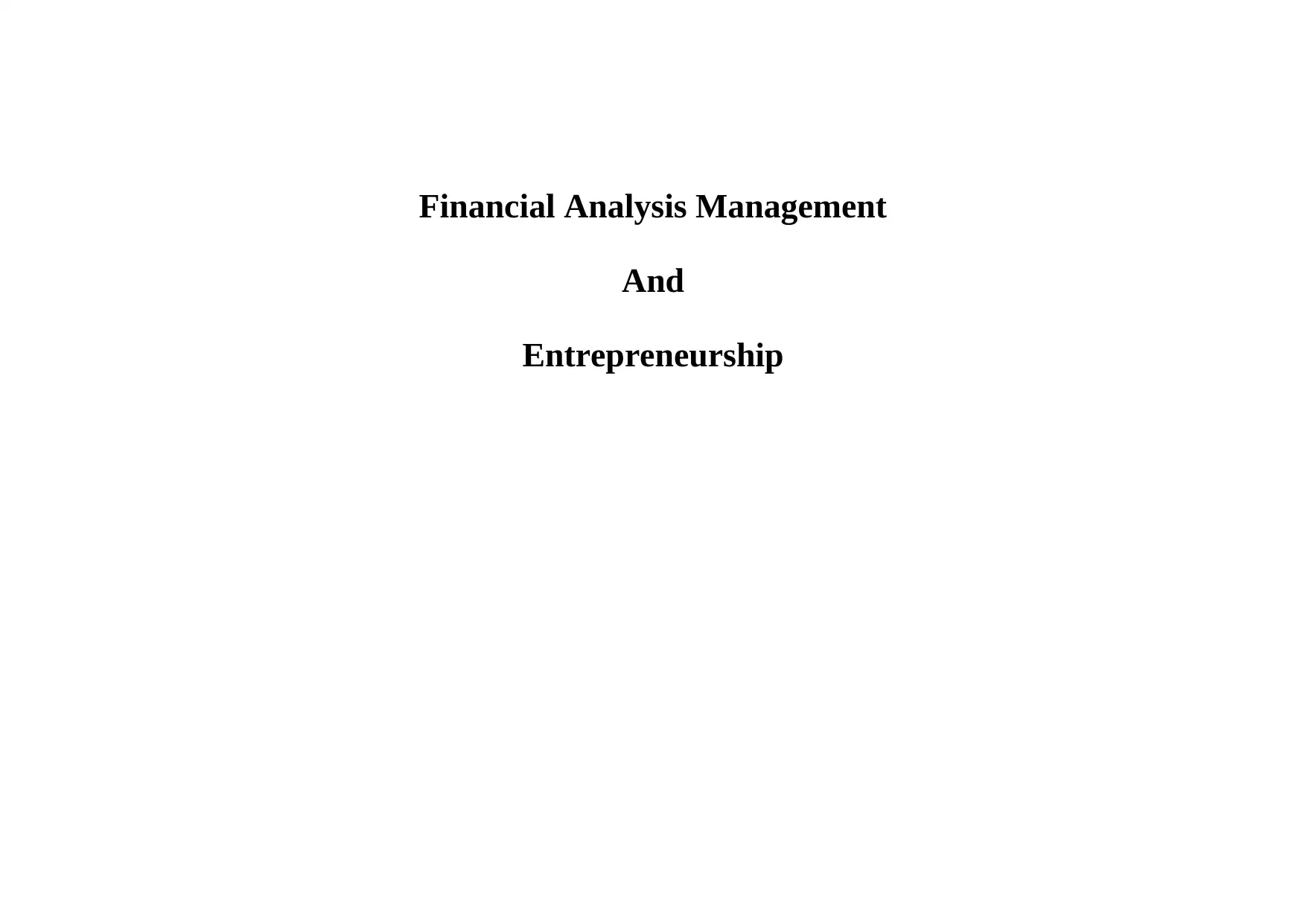
Financial Analysis Management
And
Entrepreneurship
And
Entrepreneurship
Paraphrase This Document
Need a fresh take? Get an instant paraphrase of this document with our AI Paraphraser
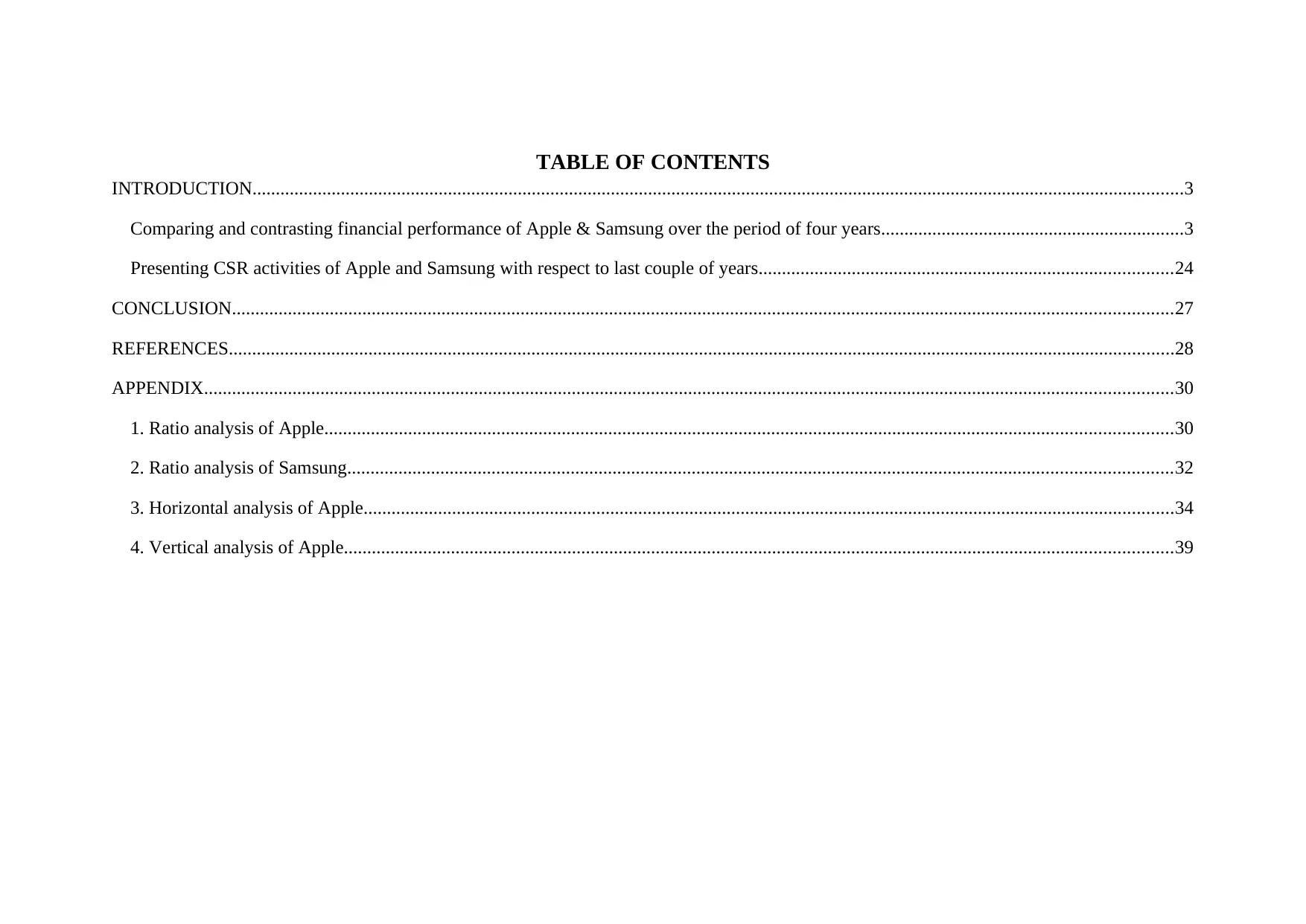
TABLE OF CONTENTS
INTRODUCTION........................................................................................................................................................................................................3
Comparing and contrasting financial performance of Apple & Samsung over the period of four years.................................................................3
Presenting CSR activities of Apple and Samsung with respect to last couple of years.........................................................................................24
CONCLUSION..........................................................................................................................................................................................................27
REFERENCES...........................................................................................................................................................................................................28
APPENDIX................................................................................................................................................................................................................30
1. Ratio analysis of Apple......................................................................................................................................................................................30
2. Ratio analysis of Samsung.................................................................................................................................................................................32
3. Horizontal analysis of Apple..............................................................................................................................................................................34
4. Vertical analysis of Apple..................................................................................................................................................................................39
INTRODUCTION........................................................................................................................................................................................................3
Comparing and contrasting financial performance of Apple & Samsung over the period of four years.................................................................3
Presenting CSR activities of Apple and Samsung with respect to last couple of years.........................................................................................24
CONCLUSION..........................................................................................................................................................................................................27
REFERENCES...........................................................................................................................................................................................................28
APPENDIX................................................................................................................................................................................................................30
1. Ratio analysis of Apple......................................................................................................................................................................................30
2. Ratio analysis of Samsung.................................................................................................................................................................................32
3. Horizontal analysis of Apple..............................................................................................................................................................................34
4. Vertical analysis of Apple..................................................................................................................................................................................39
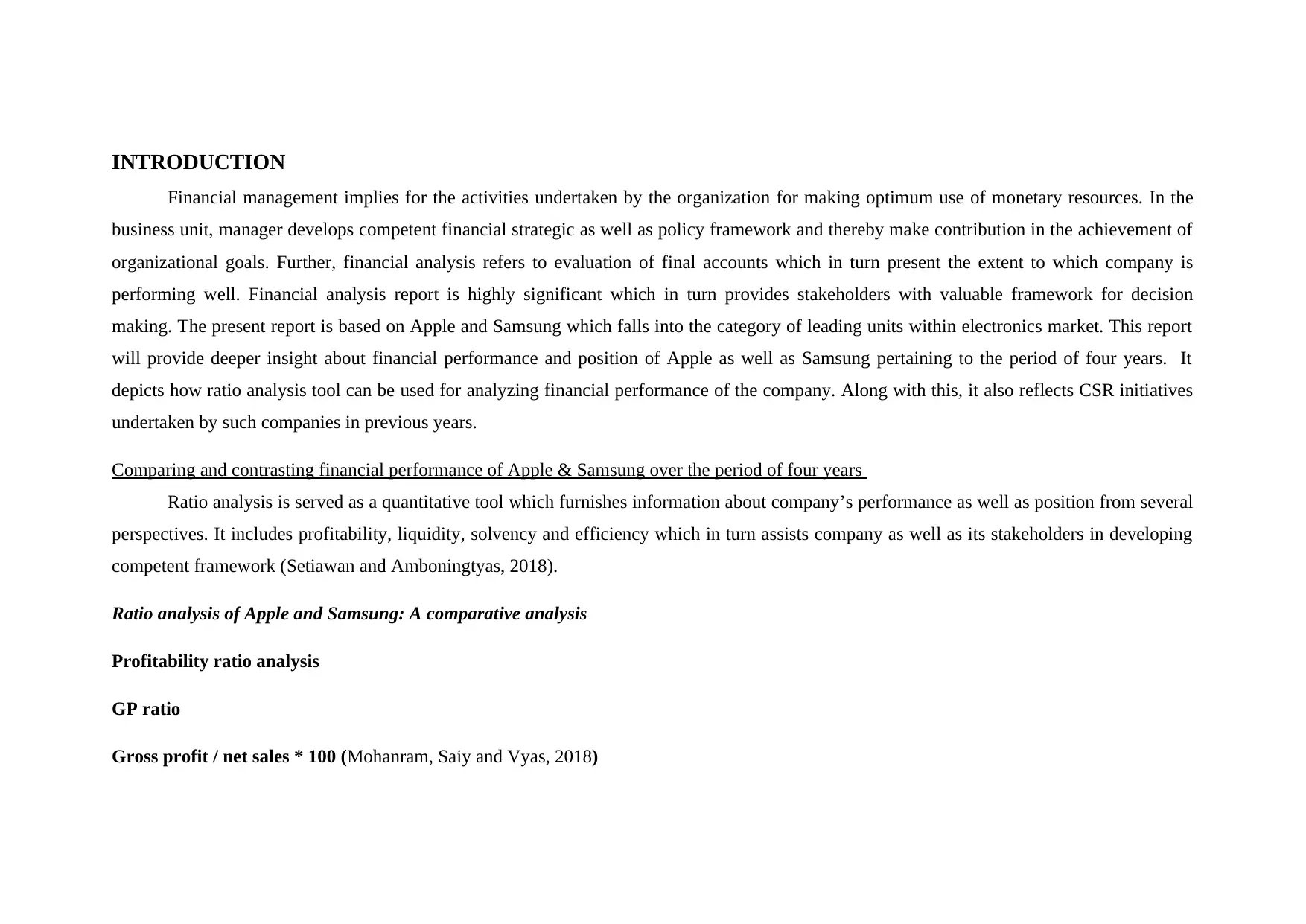
INTRODUCTION
Financial management implies for the activities undertaken by the organization for making optimum use of monetary resources. In the
business unit, manager develops competent financial strategic as well as policy framework and thereby make contribution in the achievement of
organizational goals. Further, financial analysis refers to evaluation of final accounts which in turn present the extent to which company is
performing well. Financial analysis report is highly significant which in turn provides stakeholders with valuable framework for decision
making. The present report is based on Apple and Samsung which falls into the category of leading units within electronics market. This report
will provide deeper insight about financial performance and position of Apple as well as Samsung pertaining to the period of four years. It
depicts how ratio analysis tool can be used for analyzing financial performance of the company. Along with this, it also reflects CSR initiatives
undertaken by such companies in previous years.
Comparing and contrasting financial performance of Apple & Samsung over the period of four years
Ratio analysis is served as a quantitative tool which furnishes information about company’s performance as well as position from several
perspectives. It includes profitability, liquidity, solvency and efficiency which in turn assists company as well as its stakeholders in developing
competent framework (Setiawan and Amboningtyas, 2018).
Ratio analysis of Apple and Samsung: A comparative analysis
Profitability ratio analysis
GP ratio
Gross profit / net sales * 100 (Mohanram, Saiy and Vyas, 2018)
Financial management implies for the activities undertaken by the organization for making optimum use of monetary resources. In the
business unit, manager develops competent financial strategic as well as policy framework and thereby make contribution in the achievement of
organizational goals. Further, financial analysis refers to evaluation of final accounts which in turn present the extent to which company is
performing well. Financial analysis report is highly significant which in turn provides stakeholders with valuable framework for decision
making. The present report is based on Apple and Samsung which falls into the category of leading units within electronics market. This report
will provide deeper insight about financial performance and position of Apple as well as Samsung pertaining to the period of four years. It
depicts how ratio analysis tool can be used for analyzing financial performance of the company. Along with this, it also reflects CSR initiatives
undertaken by such companies in previous years.
Comparing and contrasting financial performance of Apple & Samsung over the period of four years
Ratio analysis is served as a quantitative tool which furnishes information about company’s performance as well as position from several
perspectives. It includes profitability, liquidity, solvency and efficiency which in turn assists company as well as its stakeholders in developing
competent framework (Setiawan and Amboningtyas, 2018).
Ratio analysis of Apple and Samsung: A comparative analysis
Profitability ratio analysis
GP ratio
Gross profit / net sales * 100 (Mohanram, Saiy and Vyas, 2018)
⊘ This is a preview!⊘
Do you want full access?
Subscribe today to unlock all pages.

Trusted by 1+ million students worldwide
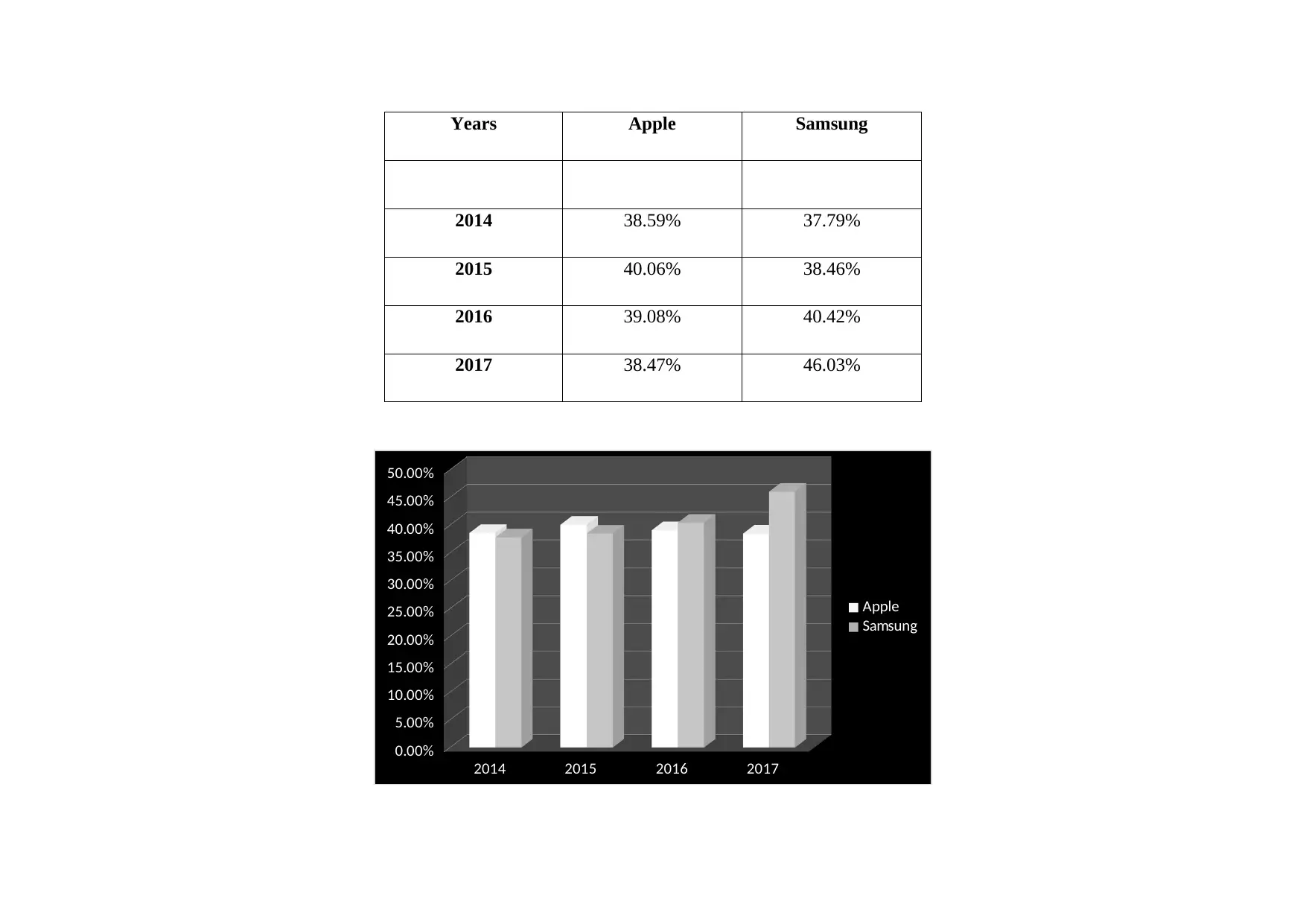
Years Apple Samsung
2014 38.59% 37.79%
2015 40.06% 38.46%
2016 39.08% 40.42%
2017 38.47% 46.03%
2014 2015 2016 2017
0.00%
5.00%
10.00%
15.00%
20.00%
25.00%
30.00%
35.00%
40.00%
45.00%
50.00%
Apple
Samsung
2014 38.59% 37.79%
2015 40.06% 38.46%
2016 39.08% 40.42%
2017 38.47% 46.03%
2014 2015 2016 2017
0.00%
5.00%
10.00%
15.00%
20.00%
25.00%
30.00%
35.00%
40.00%
45.00%
50.00%
Apple
Samsung
Paraphrase This Document
Need a fresh take? Get an instant paraphrase of this document with our AI Paraphraser
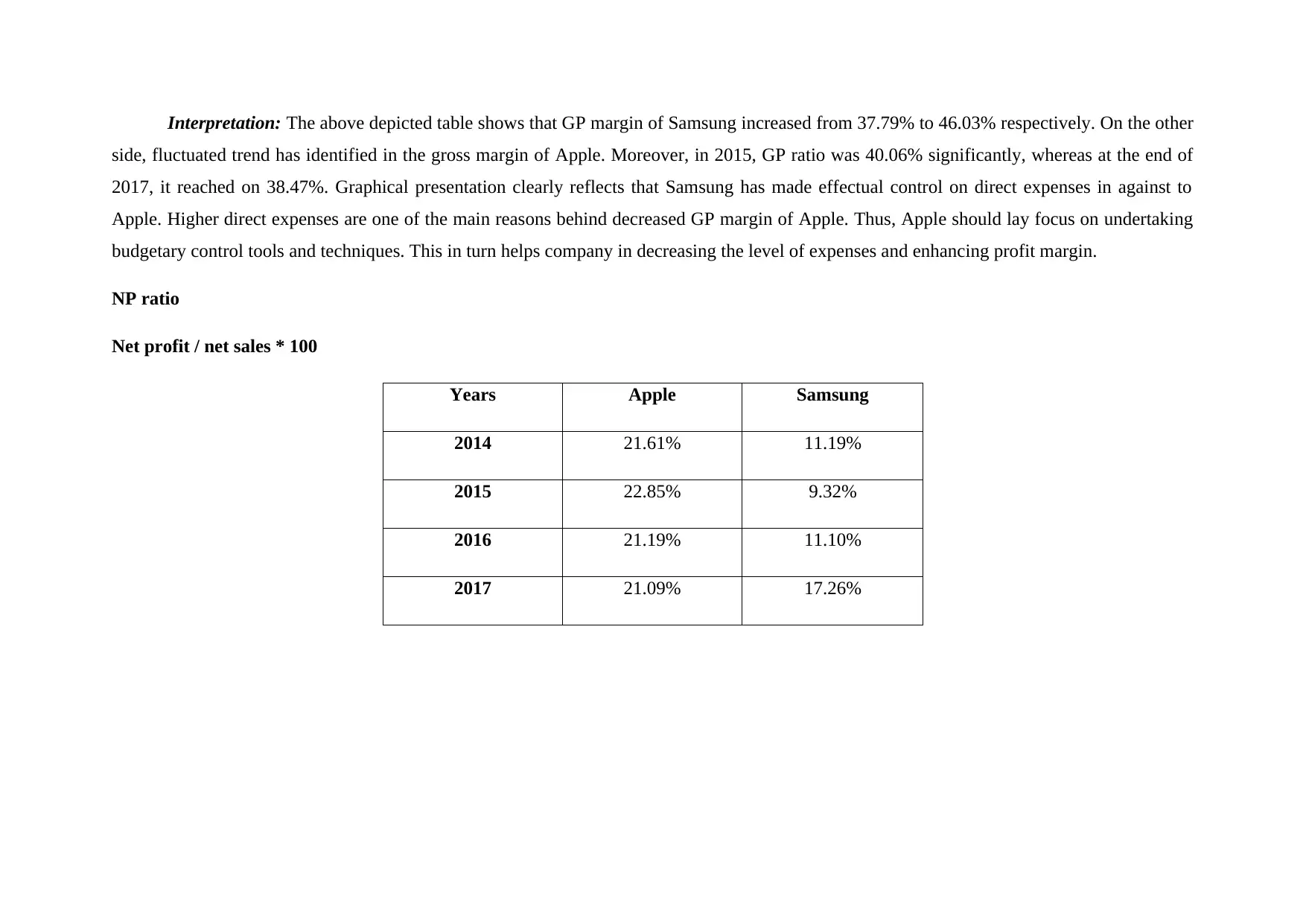
Interpretation: The above depicted table shows that GP margin of Samsung increased from 37.79% to 46.03% respectively. On the other
side, fluctuated trend has identified in the gross margin of Apple. Moreover, in 2015, GP ratio was 40.06% significantly, whereas at the end of
2017, it reached on 38.47%. Graphical presentation clearly reflects that Samsung has made effectual control on direct expenses in against to
Apple. Higher direct expenses are one of the main reasons behind decreased GP margin of Apple. Thus, Apple should lay focus on undertaking
budgetary control tools and techniques. This in turn helps company in decreasing the level of expenses and enhancing profit margin.
NP ratio
Net profit / net sales * 100
Years Apple Samsung
2014 21.61% 11.19%
2015 22.85% 9.32%
2016 21.19% 11.10%
2017 21.09% 17.26%
side, fluctuated trend has identified in the gross margin of Apple. Moreover, in 2015, GP ratio was 40.06% significantly, whereas at the end of
2017, it reached on 38.47%. Graphical presentation clearly reflects that Samsung has made effectual control on direct expenses in against to
Apple. Higher direct expenses are one of the main reasons behind decreased GP margin of Apple. Thus, Apple should lay focus on undertaking
budgetary control tools and techniques. This in turn helps company in decreasing the level of expenses and enhancing profit margin.
NP ratio
Net profit / net sales * 100
Years Apple Samsung
2014 21.61% 11.19%
2015 22.85% 9.32%
2016 21.19% 11.10%
2017 21.09% 17.26%
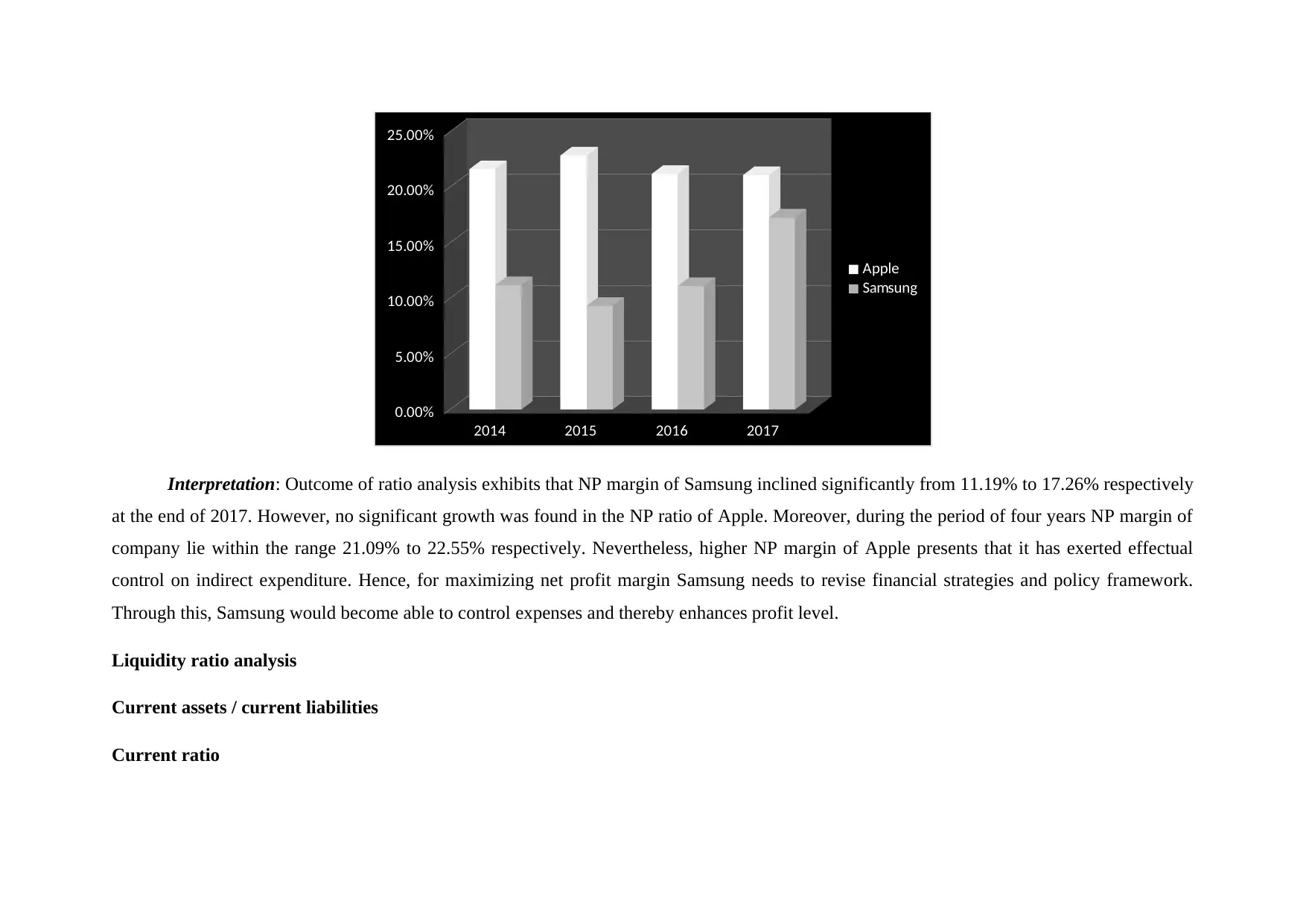
2014 2015 2016 2017
0.00%
5.00%
10.00%
15.00%
20.00%
25.00%
Apple
Samsung
Interpretation: Outcome of ratio analysis exhibits that NP margin of Samsung inclined significantly from 11.19% to 17.26% respectively
at the end of 2017. However, no significant growth was found in the NP ratio of Apple. Moreover, during the period of four years NP margin of
company lie within the range 21.09% to 22.55% respectively. Nevertheless, higher NP margin of Apple presents that it has exerted effectual
control on indirect expenditure. Hence, for maximizing net profit margin Samsung needs to revise financial strategies and policy framework.
Through this, Samsung would become able to control expenses and thereby enhances profit level.
Liquidity ratio analysis
Current assets / current liabilities
Current ratio
0.00%
5.00%
10.00%
15.00%
20.00%
25.00%
Apple
Samsung
Interpretation: Outcome of ratio analysis exhibits that NP margin of Samsung inclined significantly from 11.19% to 17.26% respectively
at the end of 2017. However, no significant growth was found in the NP ratio of Apple. Moreover, during the period of four years NP margin of
company lie within the range 21.09% to 22.55% respectively. Nevertheless, higher NP margin of Apple presents that it has exerted effectual
control on indirect expenditure. Hence, for maximizing net profit margin Samsung needs to revise financial strategies and policy framework.
Through this, Samsung would become able to control expenses and thereby enhances profit level.
Liquidity ratio analysis
Current assets / current liabilities
Current ratio
⊘ This is a preview!⊘
Do you want full access?
Subscribe today to unlock all pages.

Trusted by 1+ million students worldwide
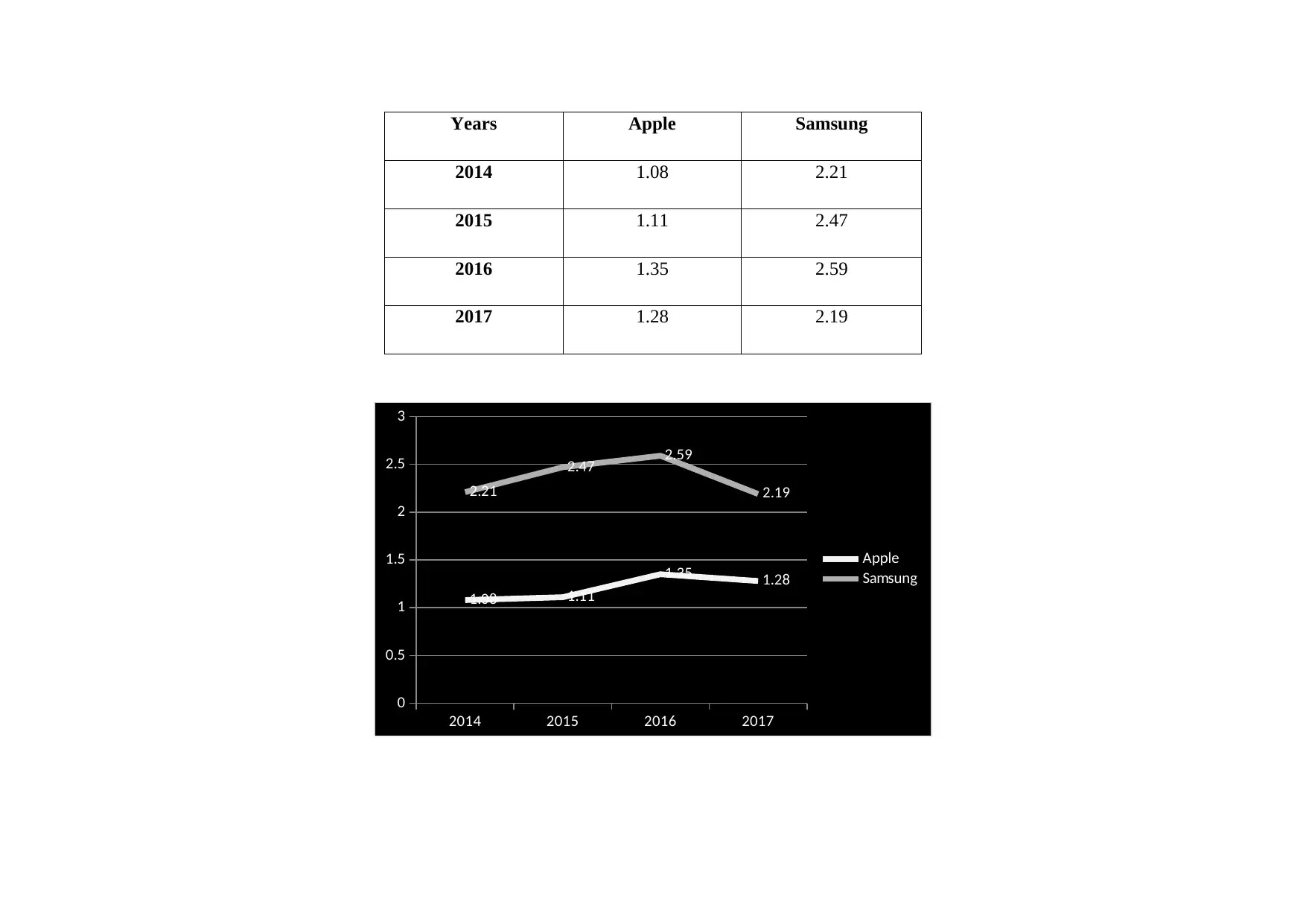
Years Apple Samsung
2014 1.08 2.21
2015 1.11 2.47
2016 1.35 2.59
2017 1.28 2.19
2014 2015 2016 2017
0
0.5
1
1.5
2
2.5
3
1.08 1.11
1.35 1.28
2.21
2.47 2.59
2.19
Apple
Samsung
2014 1.08 2.21
2015 1.11 2.47
2016 1.35 2.59
2017 1.28 2.19
2014 2015 2016 2017
0
0.5
1
1.5
2
2.5
3
1.08 1.11
1.35 1.28
2.21
2.47 2.59
2.19
Apple
Samsung
Paraphrase This Document
Need a fresh take? Get an instant paraphrase of this document with our AI Paraphraser
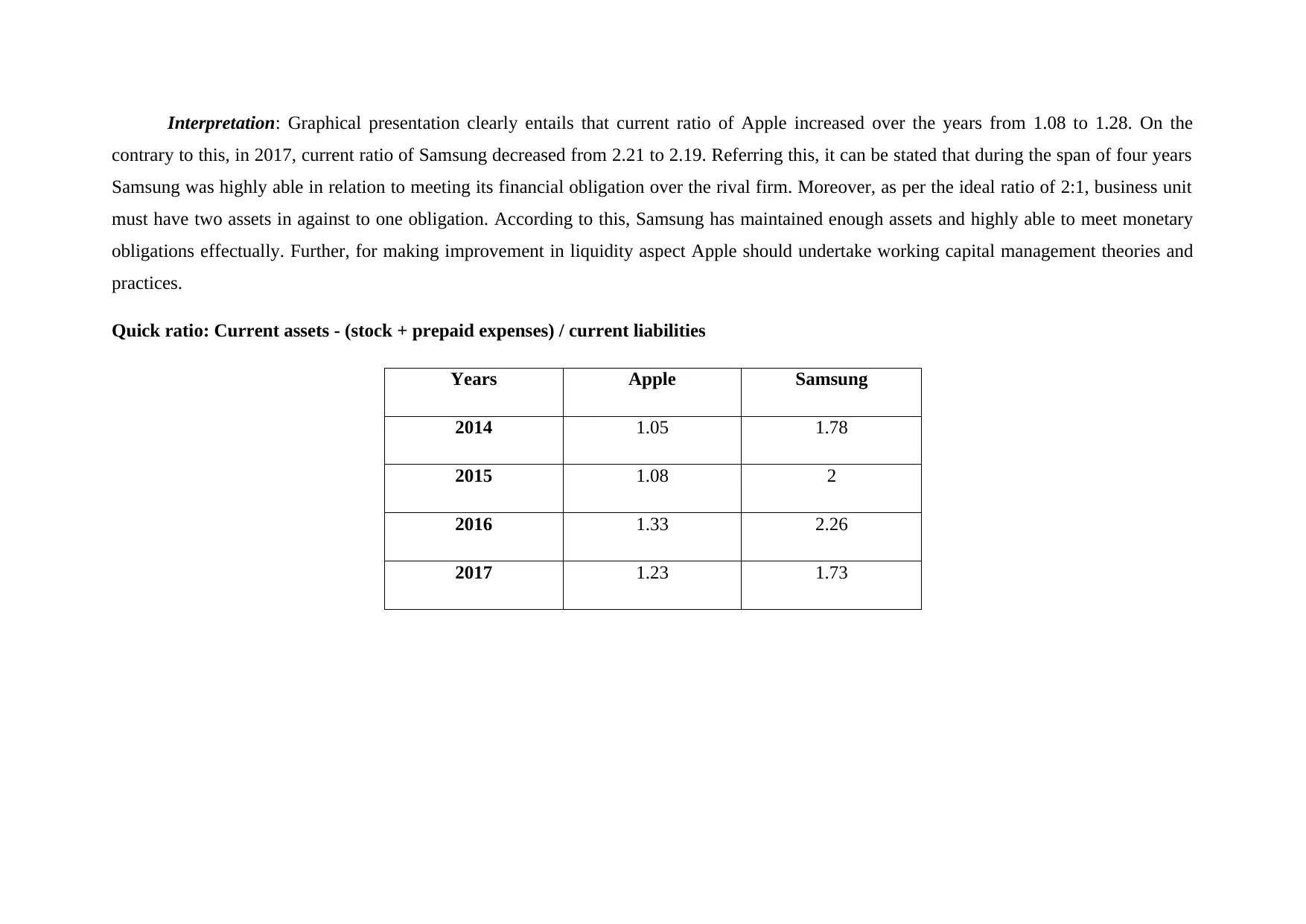
Interpretation: Graphical presentation clearly entails that current ratio of Apple increased over the years from 1.08 to 1.28. On the
contrary to this, in 2017, current ratio of Samsung decreased from 2.21 to 2.19. Referring this, it can be stated that during the span of four years
Samsung was highly able in relation to meeting its financial obligation over the rival firm. Moreover, as per the ideal ratio of 2:1, business unit
must have two assets in against to one obligation. According to this, Samsung has maintained enough assets and highly able to meet monetary
obligations effectually. Further, for making improvement in liquidity aspect Apple should undertake working capital management theories and
practices.
Quick ratio: Current assets - (stock + prepaid expenses) / current liabilities
Years Apple Samsung
2014 1.05 1.78
2015 1.08 2
2016 1.33 2.26
2017 1.23 1.73
contrary to this, in 2017, current ratio of Samsung decreased from 2.21 to 2.19. Referring this, it can be stated that during the span of four years
Samsung was highly able in relation to meeting its financial obligation over the rival firm. Moreover, as per the ideal ratio of 2:1, business unit
must have two assets in against to one obligation. According to this, Samsung has maintained enough assets and highly able to meet monetary
obligations effectually. Further, for making improvement in liquidity aspect Apple should undertake working capital management theories and
practices.
Quick ratio: Current assets - (stock + prepaid expenses) / current liabilities
Years Apple Samsung
2014 1.05 1.78
2015 1.08 2
2016 1.33 2.26
2017 1.23 1.73
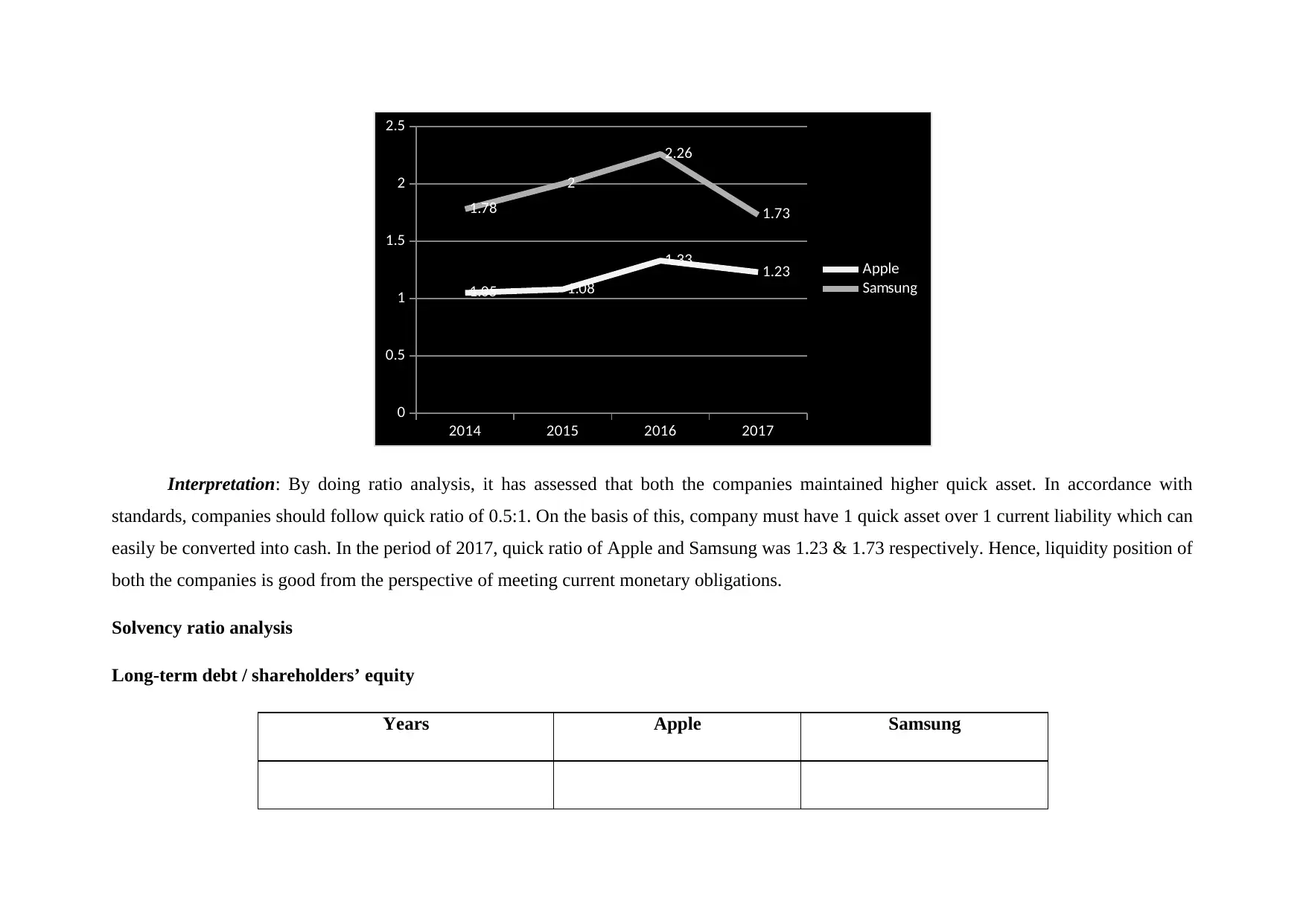
2014 2015 2016 2017
0
0.5
1
1.5
2
2.5
1.05 1.08
1.33 1.23
1.78
2
2.26
1.73
Apple
Samsung
Interpretation: By doing ratio analysis, it has assessed that both the companies maintained higher quick asset. In accordance with
standards, companies should follow quick ratio of 0.5:1. On the basis of this, company must have 1 quick asset over 1 current liability which can
easily be converted into cash. In the period of 2017, quick ratio of Apple and Samsung was 1.23 & 1.73 respectively. Hence, liquidity position of
both the companies is good from the perspective of meeting current monetary obligations.
Solvency ratio analysis
Long-term debt / shareholders’ equity
Years Apple Samsung
0
0.5
1
1.5
2
2.5
1.05 1.08
1.33 1.23
1.78
2
2.26
1.73
Apple
Samsung
Interpretation: By doing ratio analysis, it has assessed that both the companies maintained higher quick asset. In accordance with
standards, companies should follow quick ratio of 0.5:1. On the basis of this, company must have 1 quick asset over 1 current liability which can
easily be converted into cash. In the period of 2017, quick ratio of Apple and Samsung was 1.23 & 1.73 respectively. Hence, liquidity position of
both the companies is good from the perspective of meeting current monetary obligations.
Solvency ratio analysis
Long-term debt / shareholders’ equity
Years Apple Samsung
⊘ This is a preview!⊘
Do you want full access?
Subscribe today to unlock all pages.

Trusted by 1+ million students worldwide
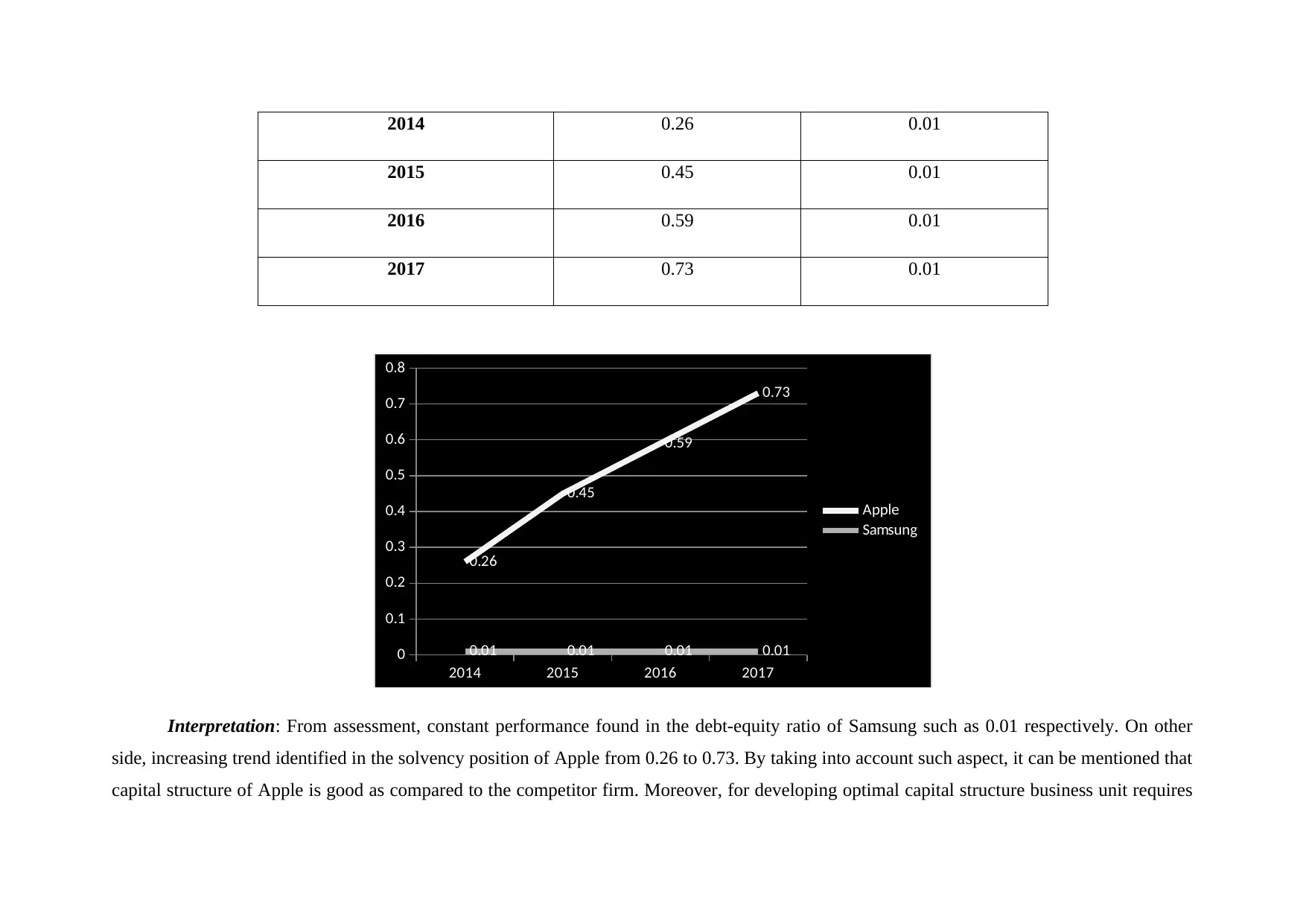
2014 0.26 0.01
2015 0.45 0.01
2016 0.59 0.01
2017 0.73 0.01
2014 2015 2016 2017
0
0.1
0.2
0.3
0.4
0.5
0.6
0.7
0.8
0.26
0.45
0.59
0.73
0.01 0.01 0.01 0.01
Apple
Samsung
Interpretation: From assessment, constant performance found in the debt-equity ratio of Samsung such as 0.01 respectively. On other
side, increasing trend identified in the solvency position of Apple from 0.26 to 0.73. By taking into account such aspect, it can be mentioned that
capital structure of Apple is good as compared to the competitor firm. Moreover, for developing optimal capital structure business unit requires
2015 0.45 0.01
2016 0.59 0.01
2017 0.73 0.01
2014 2015 2016 2017
0
0.1
0.2
0.3
0.4
0.5
0.6
0.7
0.8
0.26
0.45
0.59
0.73
0.01 0.01 0.01 0.01
Apple
Samsung
Interpretation: From assessment, constant performance found in the debt-equity ratio of Samsung such as 0.01 respectively. On other
side, increasing trend identified in the solvency position of Apple from 0.26 to 0.73. By taking into account such aspect, it can be mentioned that
capital structure of Apple is good as compared to the competitor firm. Moreover, for developing optimal capital structure business unit requires
Paraphrase This Document
Need a fresh take? Get an instant paraphrase of this document with our AI Paraphraser
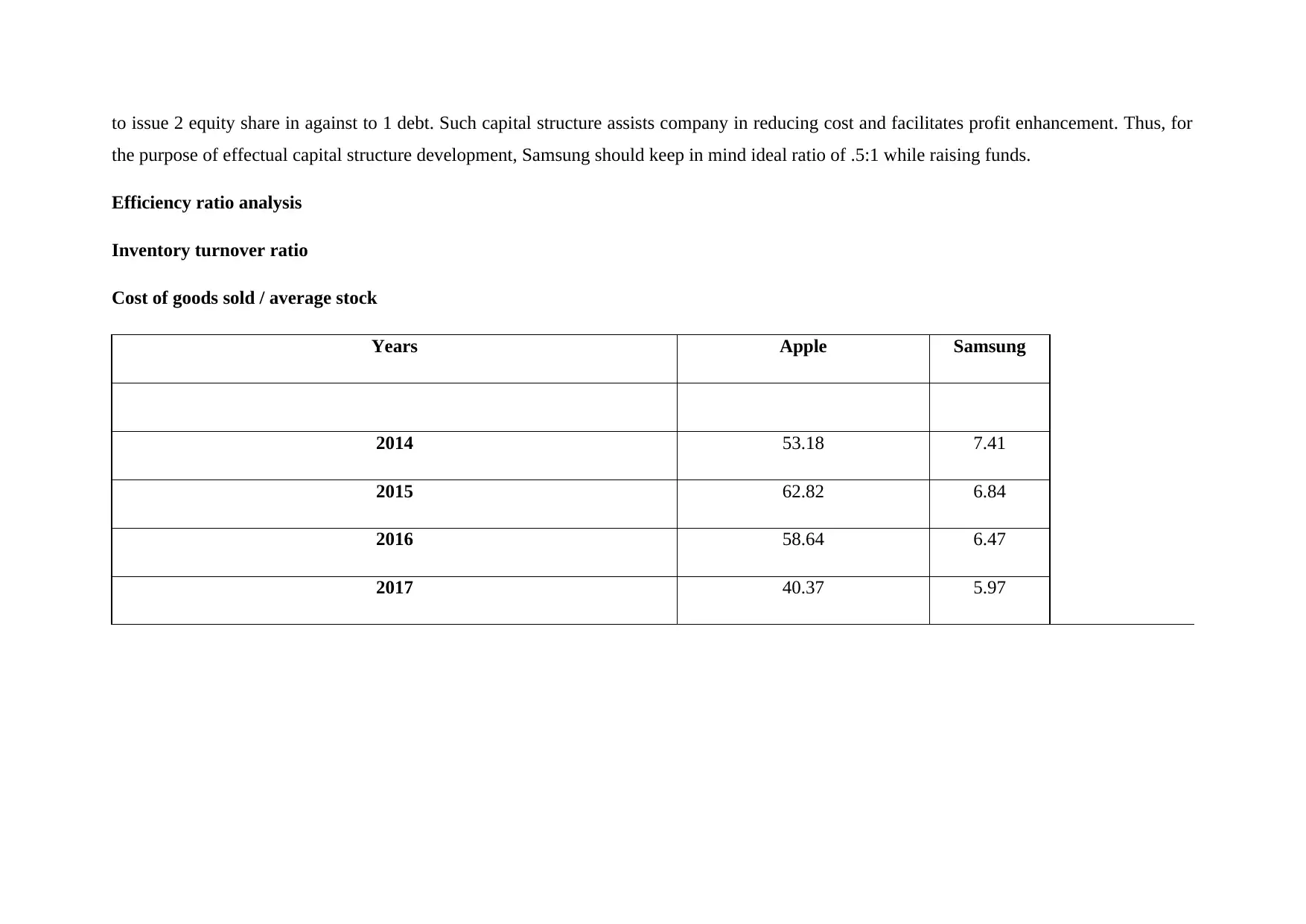
to issue 2 equity share in against to 1 debt. Such capital structure assists company in reducing cost and facilitates profit enhancement. Thus, for
the purpose of effectual capital structure development, Samsung should keep in mind ideal ratio of .5:1 while raising funds.
Efficiency ratio analysis
Inventory turnover ratio
Cost of goods sold / average stock
Years Apple Samsung
2014 53.18 7.41
2015 62.82 6.84
2016 58.64 6.47
2017 40.37 5.97
the purpose of effectual capital structure development, Samsung should keep in mind ideal ratio of .5:1 while raising funds.
Efficiency ratio analysis
Inventory turnover ratio
Cost of goods sold / average stock
Years Apple Samsung
2014 53.18 7.41
2015 62.82 6.84
2016 58.64 6.47
2017 40.37 5.97
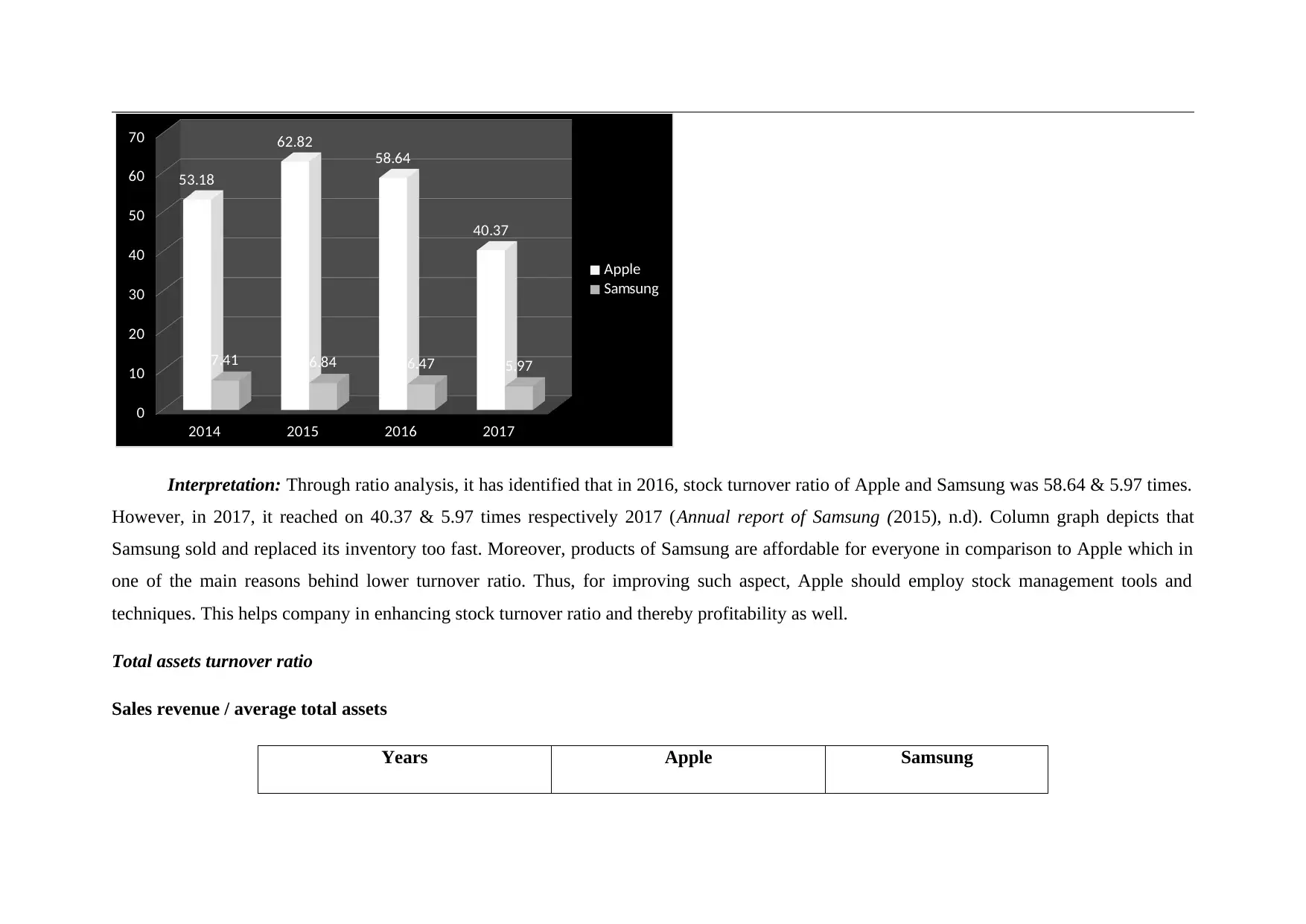
2014 2015 2016 2017
0
10
20
30
40
50
60
70
53.18
62.82
58.64
40.37
7.41 6.84 6.47 5.97
Apple
Samsung
Interpretation: Through ratio analysis, it has identified that in 2016, stock turnover ratio of Apple and Samsung was 58.64 & 5.97 times.
However, in 2017, it reached on 40.37 & 5.97 times respectively 2017 (Annual report of Samsung (2015), n.d). Column graph depicts that
Samsung sold and replaced its inventory too fast. Moreover, products of Samsung are affordable for everyone in comparison to Apple which in
one of the main reasons behind lower turnover ratio. Thus, for improving such aspect, Apple should employ stock management tools and
techniques. This helps company in enhancing stock turnover ratio and thereby profitability as well.
Total assets turnover ratio
Sales revenue / average total assets
Years Apple Samsung
0
10
20
30
40
50
60
70
53.18
62.82
58.64
40.37
7.41 6.84 6.47 5.97
Apple
Samsung
Interpretation: Through ratio analysis, it has identified that in 2016, stock turnover ratio of Apple and Samsung was 58.64 & 5.97 times.
However, in 2017, it reached on 40.37 & 5.97 times respectively 2017 (Annual report of Samsung (2015), n.d). Column graph depicts that
Samsung sold and replaced its inventory too fast. Moreover, products of Samsung are affordable for everyone in comparison to Apple which in
one of the main reasons behind lower turnover ratio. Thus, for improving such aspect, Apple should employ stock management tools and
techniques. This helps company in enhancing stock turnover ratio and thereby profitability as well.
Total assets turnover ratio
Sales revenue / average total assets
Years Apple Samsung
⊘ This is a preview!⊘
Do you want full access?
Subscribe today to unlock all pages.

Trusted by 1+ million students worldwide
1 out of 42
Related Documents
Your All-in-One AI-Powered Toolkit for Academic Success.
+13062052269
info@desklib.com
Available 24*7 on WhatsApp / Email
![[object Object]](/_next/static/media/star-bottom.7253800d.svg)
Unlock your academic potential
Copyright © 2020–2025 A2Z Services. All Rights Reserved. Developed and managed by ZUCOL.





